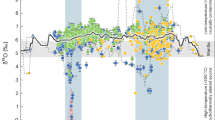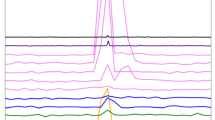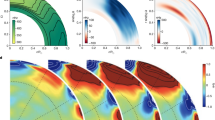Abstract
SURFACE abundances in the Sun could have been essentially caused by accretion, either of comets or of grains1–3. It has been hypothesised that if surface convection zones could be smaller than is usually indicated by model calculations, then accretion could be especially important. Dust accretion by the Sun has also been suggested as the cause of ice ages on the earth4. Either the zone immediately below the surface convection zone is stable enough for diffusion to be important, however, or other transport processes (turbulence, meridional circulation) more efficient than diffusion, will tend to homogenise the star. Diffusion is the slowest of the transport processes and will become important when the other transport processes become inoperative. Using diffusion theory, we can determine the minimum mass of the convection zone, if transport processes at the bottom of the convection zone are not to influence the abundances in the convection zone. If diffusion time scales are shorter than the life of the star, diffusion will modify the abundances in the convection zone. The mass in the convection zone for which diffusion time scales are equal to the life of the star on the main sequence then determines the minimum mass in the convection zone to justify neglect of transport processes at the bottom of the convection zone. I determine here that, for the Sun, this mass is between 3 × 10−3 and 10−2M⊙, and give a general expression for the diffusion time scale as a function of the mass of the convection zone.
This is a preview of subscription content, access via your institution
Access options
Subscribe to this journal
Receive 51 print issues and online access
$199.00 per year
only $3.90 per issue
Buy this article
- Purchase on Springer Link
- Instant access to full article PDF
Prices may be subject to local taxes which are calculated during checkout
Similar content being viewed by others
References
Joss P. C. Asrophys. J. 191, 771–774 (1974).
Newman, M. J. & Talbot, R. J. Nature 262, 559–560 (1976).
Auman, J. R. & McCrea, W. H. Nature 262, 560–561 (1976).
McCrea, W. H. Nature 255, 607–609 (1975).
Schatzman, E. Astr. Astrophys. 3, 331–346 (1969).
Michaud, G., Charland, Y., Vauclair S. & Vauclair G. Astrophys. J. 210, 447–465 (1976).
Aller L. H. & Chapman, S. Astrophys. J. 132, 461–472 (1960).
Montmerle T. & Michaud G. Astrophys. J. Suppl. 31, 489–515 (1976).
Author information
Authors and Affiliations
Rights and permissions
About this article
Cite this article
MICHAUD, G. Diffusion time scales and accretion in the Sun. Nature 266, 433–434 (1977). https://doi.org/10.1038/266433a0
Received:
Accepted:
Published:
Issue Date:
DOI: https://doi.org/10.1038/266433a0
This article is cited by
-
Solar neutrinos and turbulent diffusion
Nature (1981)
Comments
By submitting a comment you agree to abide by our Terms and Community Guidelines. If you find something abusive or that does not comply with our terms or guidelines please flag it as inappropriate.



